Basic Macaron Recipe
This basic macaron recipe is perfect for beginners. In this post, you’ll find all my tips and tricks for perfectly full shells with pretty little feet and smooth tops, as well as my detailed video tutorial to walk you through the entire process!I’m not holding anything back!!
These dainty little almond cookies are simply divine! And I’m here to help you find your groove with these finicky cookies!
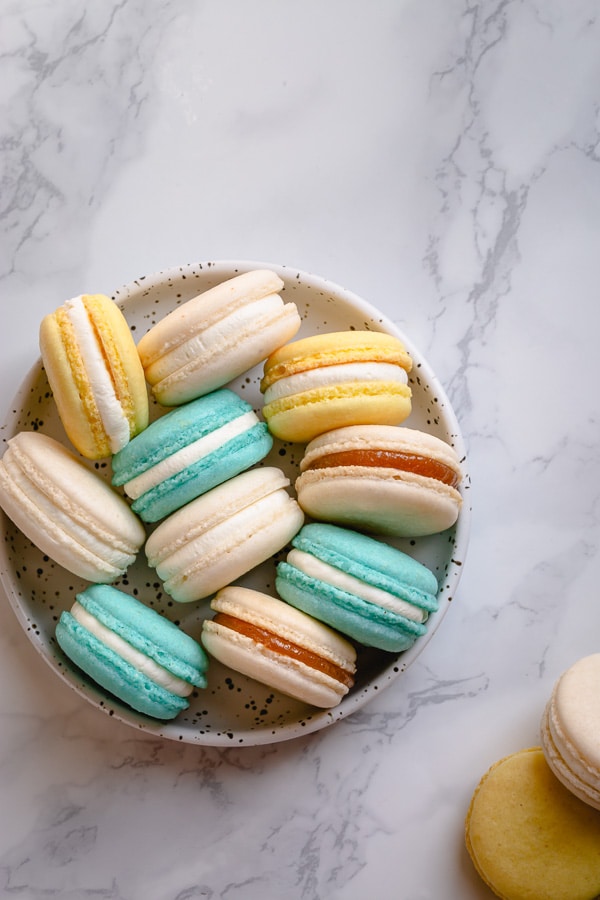
Now, a fair warning… This’s a long article! I wanted to cover all the details in making a perfect batch of macarons. And my hope for this post is to be your go-to resource for perfecting these iconic little treats.
Why you’ll love this basic macaron recipe:
While I don’t believe in foolproof macaron recipe, I can tell you that my macaron recipe has been tested by not only me, but also many of my readers with great success over the years.3 unique pro’s of my macaron recipe:
- French meringue method, which is the easiest meringue!
- Reduced sugar amount without compromising the texture!
- Tried and tested by not only me, but also hundreds of my readers.
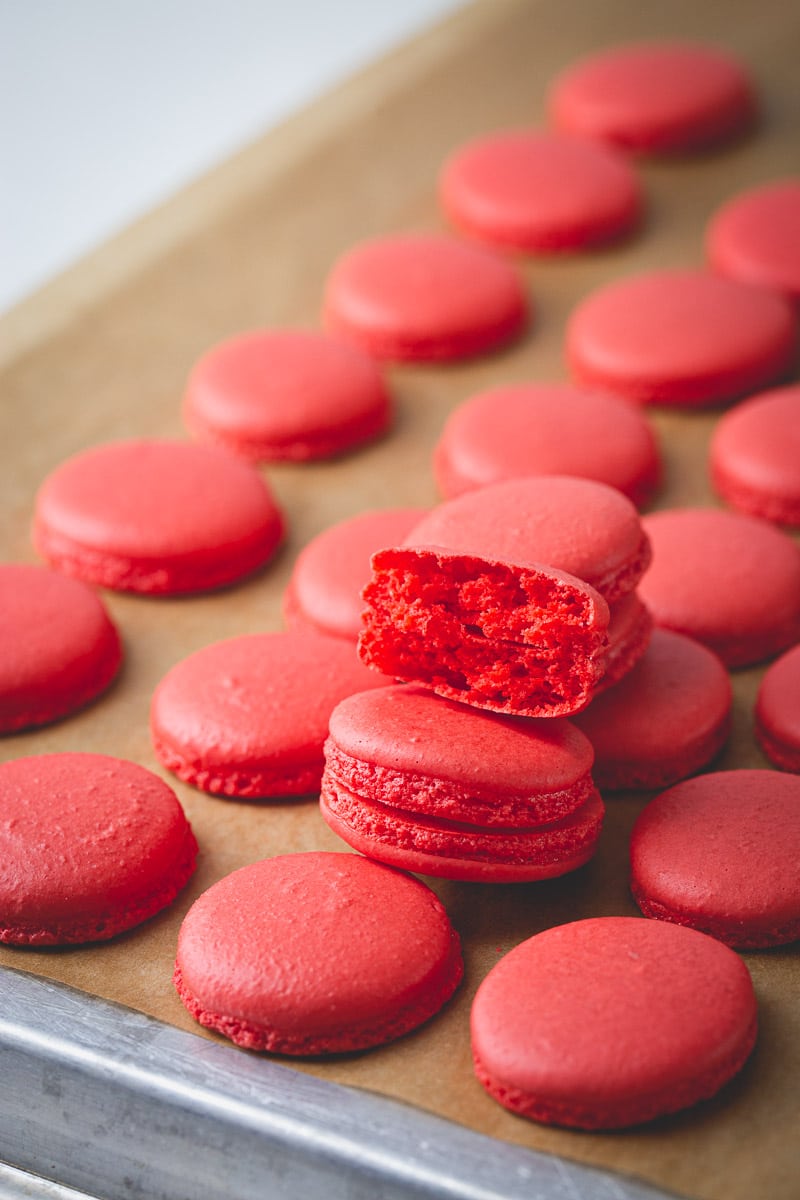
Yeah, this post is loong overdue an update!!!
It’s been more than 7 years (where did time go?!) since I published this basic macaron recipe.
And in that time, I’ve learned so much more about making perfect macarons and I’m excited to share them all with you!
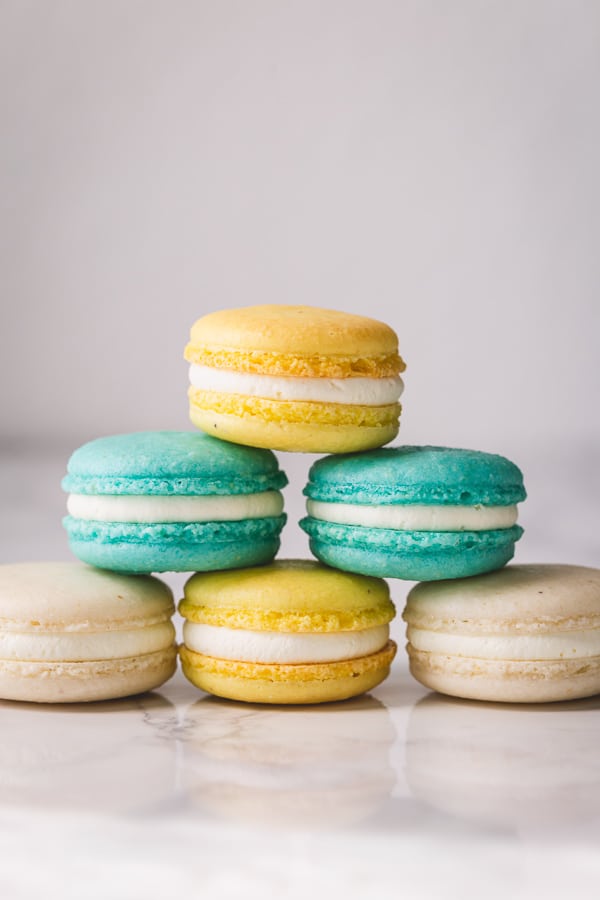
I also tweaked the recipe just a little bit to make it a little more “fool-proof”. (It turns out a little more sugar in meringue makes it that mush stronger, so I reduced the powdered sugar and increased sugar in meringue. In the end, the same amount of sugar as my original recipe, but with a little less room to mess up!)
Disclaimer: I don’t believe a foolproof macaron recipe exists, because successful macarons are a result of more than just a good recipe.
And here’s why…
4 pillars of perfect macarons:
- Precise ingredients amount
- Stable meringue
- Proper macaronage technique (mixing the batter)
- Accurate oven temperature
- Weighing the ingredients on a scale is crucial for setting yourself up for success. It’s so easy, and often unreliable, to measure the ingredients by volume. That’s why I provide only the metric measurements in my ingredients list. I really want you to have the best chance to succeed!!
- Stable meringue is the foundation of perfect macarons! If your meringue is weak, you’ll run into so many issues, like hollow macarons, no feet, etc. And I share my technique to achieve the most stable French meringue below.
- Macaronage is a step when we mix dry ingredients with meringue and fold the batter until perfect consistency!
- So, you can have the most reliable macaron recipe, measure the ingredients just right and fold the batter until the perfect consistency, and unfortunately, you can still FAIL, if your oven temperature is off. No matter how good your oven is, it’s important to find the sweet spot for YOUR oven. Every oven is different, and it’s totally normal for the oven temperature to vary 50°F up or down, which could make or break your macarons. That’s why I recommend getting an oven thermometer to double check the accuracy.
Now that you know what areas to pay attention, let’s go through every step.

HOW TO MAKE BASIC MACARONS:
Step 1. Sift dry ingredients
Sift almond flour and powdered sugar three times. Yes, three. Not only are we combining the two ingredients, we’re also aerating the dry ingredients to get that beautiful full interior.- NOTE: Unless your almond flour is chunky, I don’t recommend processing the dry ingredients in the food processor, because you may over-process the almond flour, which would lead to blotchy shells from oily almond flour.
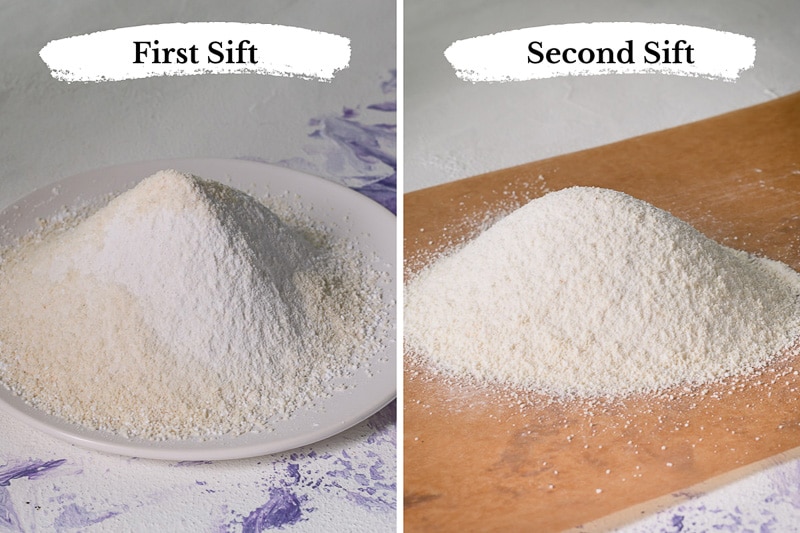
- TIP: If you have up to 2 tablespoons of chunky dry ingredients left in the sifter, you don’t have to replace it. Simply discard those chunky bits.
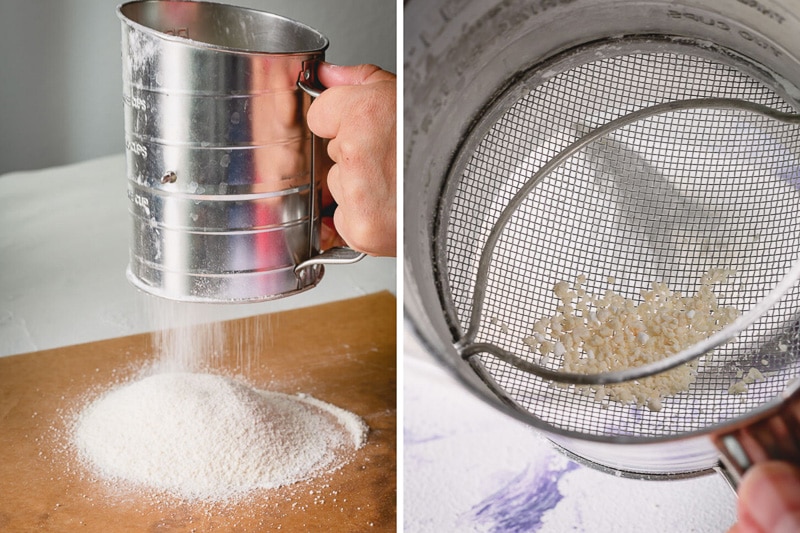
Step 2. Make the meringue
Whisk the egg whites in a large mixing bowl until foamy. Then add cream of tartar and salt, and continue beating. Once the mixture is white, start adding sugar, one tablespoon at a time, making sure the sugar is mostly dissolved before adding more.- TIP 1: Room temperature egg whites whip better and get more volume, but cold eggs separate better. So separate the egg whites right out of the fridge, and allow the egg whites come to room temperature on the counter for about 30 minutes.
- TIP 2: Make sure the mixing bowl and whisk are completely grease-free and egg whites have no yolks in it. Any trace of fat may ruin your meringue and it won’t allow your meringue reach hard peaks. Glass, stainless steel or copper bowls are the best!
- TIP 3: Use super-fine granulated sugar, or caster sugar for meringue, as it dissolves easily.
- TIP 4: Don’t rush it! Beat the meringue on low and consistent speed for the most stable meringue. I continuously whisk the egg whites on speed 2 or 4 on my KitchenAid mixer the entire time. It does take a little longer this way (12-14 minutes!), but I think it’s totally worth it!
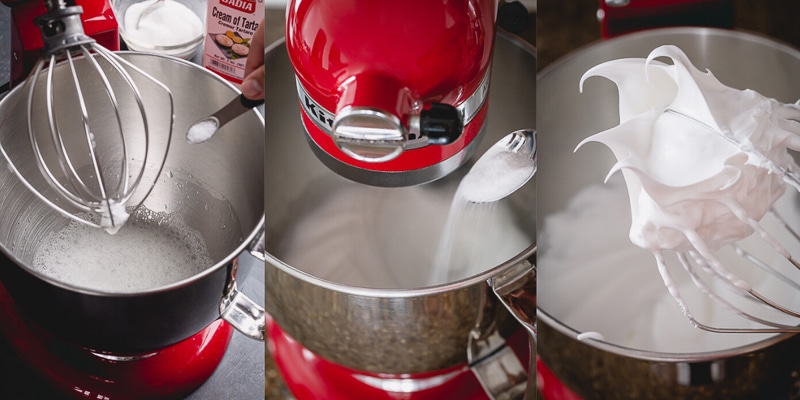
Step 3. Macaronage.
Add dry ingredients into the meringue and gently fold until incorporated, using a rubber spatula. Then fold the batter until lava-like consistency, which means the batter is thick, yet runny enough to slowly flow off the spatula in a continuous flow to draw a figure eight.- TIP: One way to test the consistency of the batter is to drop the batter into a ribbon and count to 10. If the edges of the ribbon are dissolved back into the batter in 10 seconds, the batter is ready!
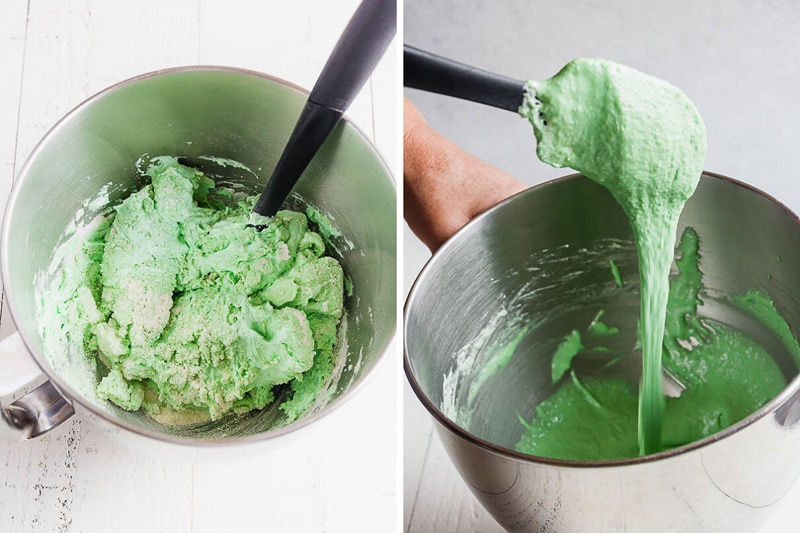
Step 4. Pipe the shells.
Transfer the batter into a piping bag, fitted with a round tip (I use Wilton 2A tip). And pipe 1.5-inch rounds on two baking sheets, lined with parchment paper.- TIP: If you need a template, I made one for you. Subscribe to my e-mail list and download this custom macaron template for FREE. (This template is perfect for my recipe and super easy to use!)
- TIP: I prefer parchment paper and teflon mat over silicone mat, because they’re thinner and conduct heat better. But out of all silicone baking mats, this thin silicone mat is the best.

Step 5. Rest and bake.
Rest the shells before baking until skin forms. This could take anywhere from 15 minutes to a few hours. It all depends on humidity. If you’re in humid climate, you may use a fan to expedite the drying process.- TIP: To test, lightly touch the top of the shell with a finger. It should be dry to the touch, and batter shouldn’t stick to your finger.
- TIP 1: To prevent browning on top, place an empty baking sheet on a top rack to shield the heat from the top.
- TIP 2: It’s better to over-bake the shells than under-bake them. If the shells are stuck to the mat, they’re not quite done yet. Check every 30-45 seconds after 18 minutes.

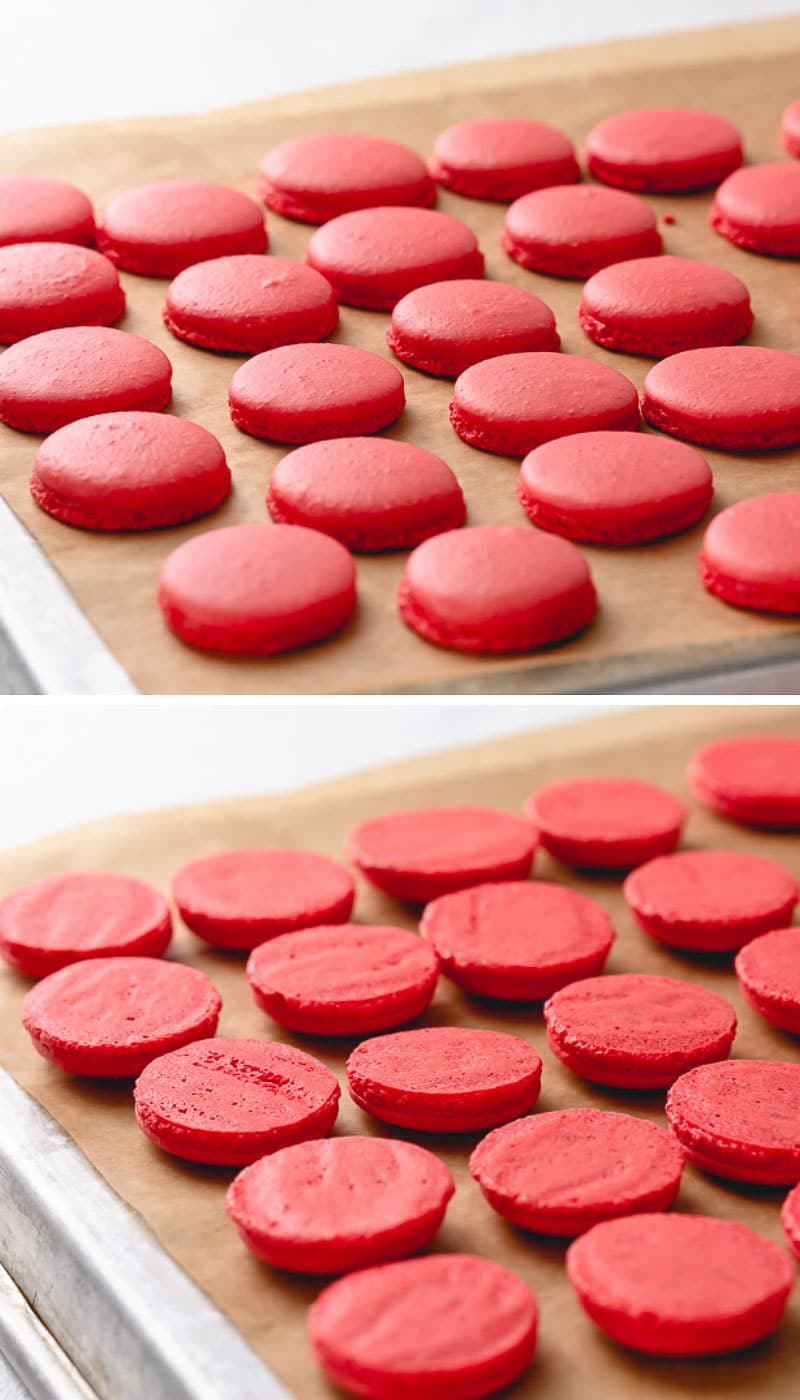
Step 6. Fill the macarons.
Fill the macarons with any kind of filling. The most common fillings are ganache, buttercream, jams and curds.Once you’ve filled the macarons, place them in an airtight container and refrigerate for at least 8 hours or preferably for 24 hours. This process is called maturing, which allows the filling to soften and flavor the shells.

HOW TO STORE MACARONS:
Unfilled macaron shells:- Store in an airtight container at room temperature for up to 2 days.
- Freeze in an airtight container for up to 3 months.
- Refrigerate in an airtight container for at least 24 hours and up to 3 days.
- Depending on the filling, you may be able to freeze them too.
Freezing Instructions:
Once matured, the filled macarons can be frozen for up to 1 month, depending on the filling.- Freeze the filled macarons in an airtight container for up to 1 month.
- To thaw, place the frozen macarons in the fridge and let them thaw slowly for at least 1 hour.
- Then, bring them out 30 minutes prior to serving.
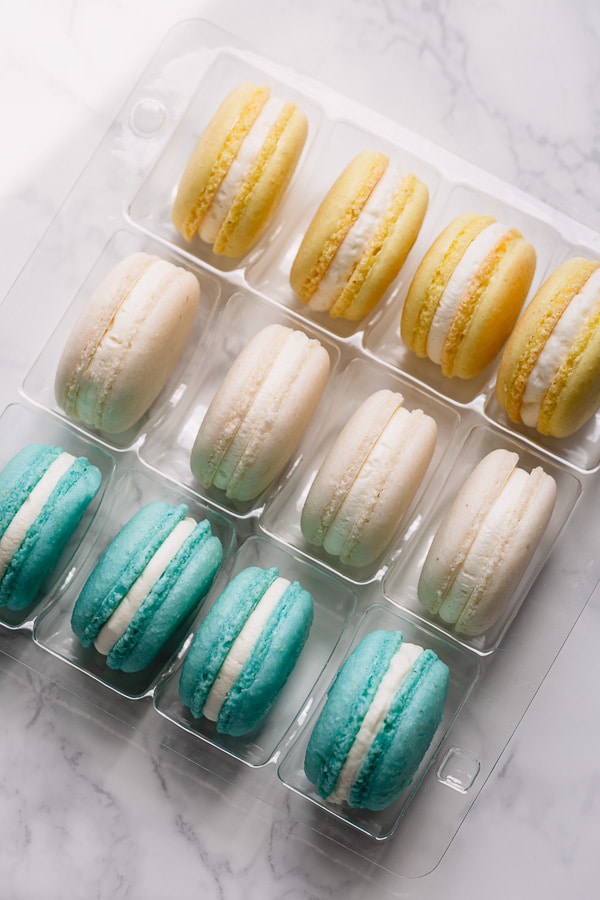
MORE MACARON RESOURCES:
I’ve shared so many macaron recipes on my blog and I’ve highlighted different aspects of making macarons in every post.So if you’d like to dive deeper into certain areas, check out the following posts:
- Lemon French Macarons – Macaronage
- Chocolate Hazelnut Macarons – Using different nut flours and nut flours in general
- Red Velvet Macarons – Food coloring
- Pumpkin Macarons – Shaped macarons
- Chocolate Macarons – Using cocoa powder
- White Chocolate Raspberry Macarons – French meringue
- Mint Macarons – Maturing and storing
- Pistachio Macarons – Piping technique
- Pure White Macarons – Baking, how to prevent browning, etc
- Strawberry Macarons – Using freeze-dried fruits
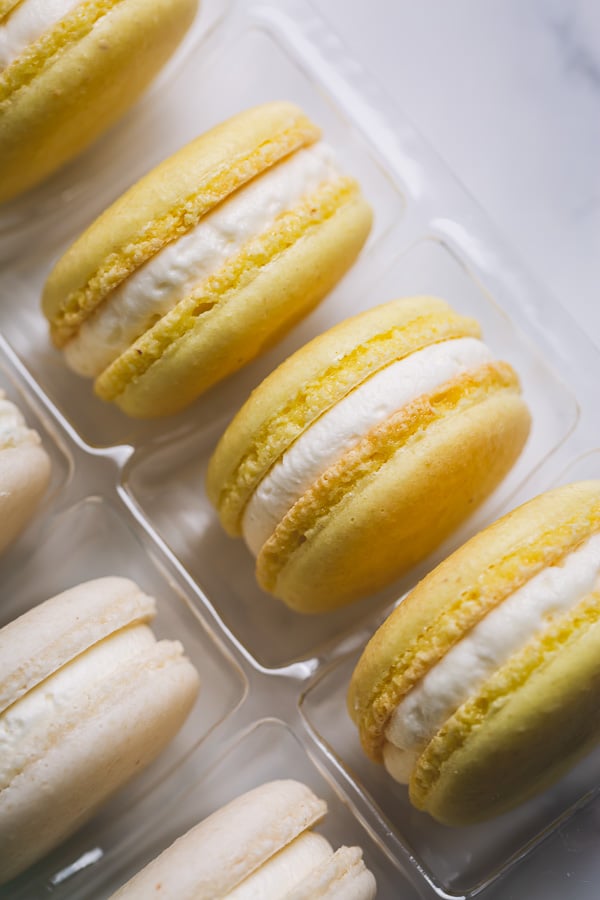

Basic Macaron Recipe
A comprehensive macaron recipe with lots of tips and tricks for perfectly full french macarons. Plus, a full video tutorial to walk you through entire process.
Yield: About 25 filled macarons
Prep Time:1 hour
Cook Time:18 minutes
Total Time:2.5 hours (Does not include time for maturing filled macarons)
Prep Time:1 hour
Cook Time:18 minutes
Total Time:2.5 hours (Does not include time for maturing filled macarons)
Ingredients:
For macaron shells:
- 100gr super fine almond flour (Note 1)
- 75gr powdered sugar/confectioners sugar (Note 2)
- 70gr (1/3 cup) egg whites, at room temperature
- 75gr fine granulated sugar (Note 3)
- ¼ teaspoon cream of tartar, optional (Note 4)
- ¼ teaspoon salt
- Gel food coloring, if desired
- 2 large egg yolks
- ¼ cup (50gr) sugar
- 3 ½ tablespoons milk
- ½ cup (115gr) unsalted butter, softened
- 1 teaspoon pure vanilla extract
Directions:
- To make macaron shells, line 2 baking sheets with parchment paper, or teflon sheet, or silicone mat. (TIP 1: For even air circulation, flip the baking sheets upside down.)
- To prepare dry ingredients, sift together almond flour and powdered sugar twice. Note: If you have up to 2 tablespoons of chunky dry ingredients left in the sifter, you don’t have to replace it. Simply discard those chunky bits.
- To make meringue, in a clean mixing bowl with a whisk attachment, beat the egg whites on medium low speed until foamy. (I set it to speed 2 or 4 on my KitchenAid stand mixer.)
- When egg whites are foamy, add cream of tartar and salt and continue to whisk.
- Then slowly add sugar one tablespoon at a time, while mixer is still running. Allow the sugar to dissolve after each addition.
- If you’re making colored shells, add gel food coloring when the meringue reaches soft peaks.
- Continue beating the egg whites on the same medium low speed until hard peaks form. Visual cues: Meringue should ball up inside the whisk, and when you lift the whisk, the meringue should hold a pointy end and have sharp ribs. (See pictures above or watch the video.)
- To make batter, sift almond flour mixture into the meringue. Using a silicone spatula, fold the dry ingredients into the meringue until fully incorporated. Then continue to fold the batter until it’s runny enough to draw a figure eight. To test, take a small amount of batter and drop it into the bowl. If the small peaks dissolve into the batter on its own in about 10 seconds, the batter is ready. If not, fold couple more times and test again. Be careful not to over-fold the batter. (TIP: Making french macarons is all about the technique. This is one of the most crucial step. Let me try to describe the folding motion as best as I can: run the spatula clockwise from the bottom, up around the sides and cut the batter in half. If you’re beginner macaron-baker, I suggest to count every fold. It takes roughly about 50 folds to reach the proper consistency. After 50 folds, start testing the batter, and continue testing after every couple folds.)
- To pipe macaron shells, transfer the batter into a pastry bag, fitted with a round tip. (I used this Wilton 2A tip.)
- Hold the pastry bag at straight 90° angle and pipe about 1.5-inch rounds about an inch apart on prepared baking sheets. (TIP 2: I made a perfect macaron template for you. Simply pipe the batter to fill inner circle.)
- Tap the baking sheets firmly on the counter (or using your hand) a few times to get rid of any air bubbles. You can also use a toothpick to burst some large air bubbles. This step ensures smooth tops.
- Let the macarons sit out on the counter for at least 15-30 minutes, maybe up to couple hours, depending on humidity. When you lightly touch the macarons and the batter does not stick to your finger, then it’s ready to go into the oven.
- Meanwhile, preheat the oven to 300°F (150°C). Note: I don’t use convection settings. I set my oven to heat from top and bottom.
- To bake, working one baking sheet at a time, place one tray with macarons on the middle rack. (TIP: To prevent browning, place an empty baking sheet on top rack to shield the heat.) Bake for about 15-18 minutes. It’ll take longer for larger macarons. To test for doneness, touch a macaron lightly and try to move it. If it slides and wobbles, bake a minute or so longer. The cooked macarons should be firm to touch and the base shouldn’t move. (TIP: It’s always better to slightly over-bake macarons than under-bake them!)
- Cool the macarons on the sheet for 10-15 minutes, and then transfer onto a wire rack to cool completely.
- To make the buttercream filling, in a medium bowl, beat the egg yolks slightly with a whisk and add sugar. Continue to whisk until the mixture is pale and sugar is mostly dissolved. Stir in the milk. Transfer the egg yolk mixture into a small saucepan and heat over low heat, stirring frequently. Continue to cook until it’s thick like pudding, about 5 minutes. Transfer the mixture back to the bowl and bring it to room temperature. Stir in the butter in three batches. Add vanilla extract and continue to mix until smooth. Transfer the buttercream into a pastry bag with round tip.
- To assemble macarons, pair the macaron shells by size and arrange them on a wire rack. Line them up so that bottom shells are upside down.
- Pipe a dollop of filling on bottom shells. Place the top shell over the filling and press lightly so the filling spreads till the edges.
- Store the filled macarons in an airtight container in the fridge for at least 24 hours to mature, which allows the filling to soften and flavor the shells.
- To serve, bring the macarons out about 30 minutes prior to serving.
Note 1: It’s best to use super fine almond flour to ensure smooth tops. Weigh the ingredients before sifting.
Note 2: I don’t recommend making your own powder sugar, because commercial powdered sugar has cornstarch in it. And it helps with texture of the cookies.
Note 3: It’s important to use fine granulated sugar for meringue, as it dissolves quicker. You can also use caster sugar, aka baker’s sugar.
Note 4: Cream of tartar is optional and can’t be omitted. However, it helps to stabilize egg whites and create sturdier meringue. It’s just an extra insurance!
Note 5: You can easily double this macaron recipe.
Note 6: Read this post for must-have macaron tools.
Got macaron trouble? Check out my visual troubleshooting guide and Macaron 101 post.
Note 2: I don’t recommend making your own powder sugar, because commercial powdered sugar has cornstarch in it. And it helps with texture of the cookies.
Note 3: It’s important to use fine granulated sugar for meringue, as it dissolves quicker. You can also use caster sugar, aka baker’s sugar.
Note 4: Cream of tartar is optional and can’t be omitted. However, it helps to stabilize egg whites and create sturdier meringue. It’s just an extra insurance!
Note 5: You can easily double this macaron recipe.
Note 6: Read this post for must-have macaron tools.
Got macaron trouble? Check out my visual troubleshooting guide and Macaron 101 post.
How to Store Macarons:
Unfilled macaron shells:- Store in an airtight container at room temperature for up to 2 days.
- Freeze in an airtight container for up to 3 months.
- Refrigerate in an airtight container for at least 24 hours and up to 3 days.
- Depending on the filling, you may be able to freeze them too.
Freezing Instructions:
Once matured, the filled macarons can be frozen for up to 1 month, depending on the filling.- Freeze the filled macarons in an airtight container for up to 1 month.
- To thaw, place the frozen macarons in the fridge and let them thaw slowly for at least 1 hour.
- Then, bring them out 30 minutes prior to serving.
All images and text ©
All photographs and content on Sweet & Savory by Shinee is copyright protected, unless otherwise noted. Please do not use any of my photos without my authorization. If you would like to share my recipe, you may re-write the recipe in your own words, or simply link back to this post for the full directions. Thank you for your cooperation!
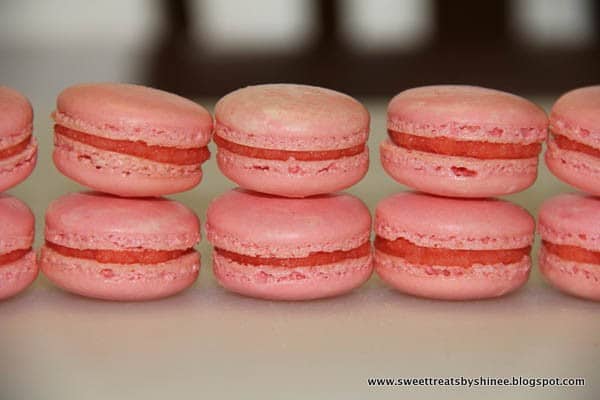
Excerpt from my original post from January 13, 2013:
Just a few months ago, these pretty little cookies popped on the screens everywhere I went. So dainty, colorful and tempting! Everyone was all ohs and ahs about how wonderful these treats are.
I’m curious person by nature. And since I could not find anything like this where I live (I live in the middle nowhere!), I googled the recipe for these beautiful treats. Found ton of recipes, read countless tips and tricks (apparently they are quite finicky!), drooled over many, many gorgeous photos, and I finally made them!
Oh, sweet little macarons, where have you been all my life? They were so absolutely delicious.
To make up for all the lost time without these gems, I was on the roll making them day and night. Ok, maybe a little exaggeration, but you got the idea, I was obsessed!
I can’t say I’ve perfected these delicate little cookies yet. But as you can see they’re not that bad.
Now, that I had made these gems more than handful of times and I’m pretty confident with the technique, and I thought I would share my process.
This recipe was originally published on January 13, 2013, and last updated on May 27th, 2020.







0 Comments